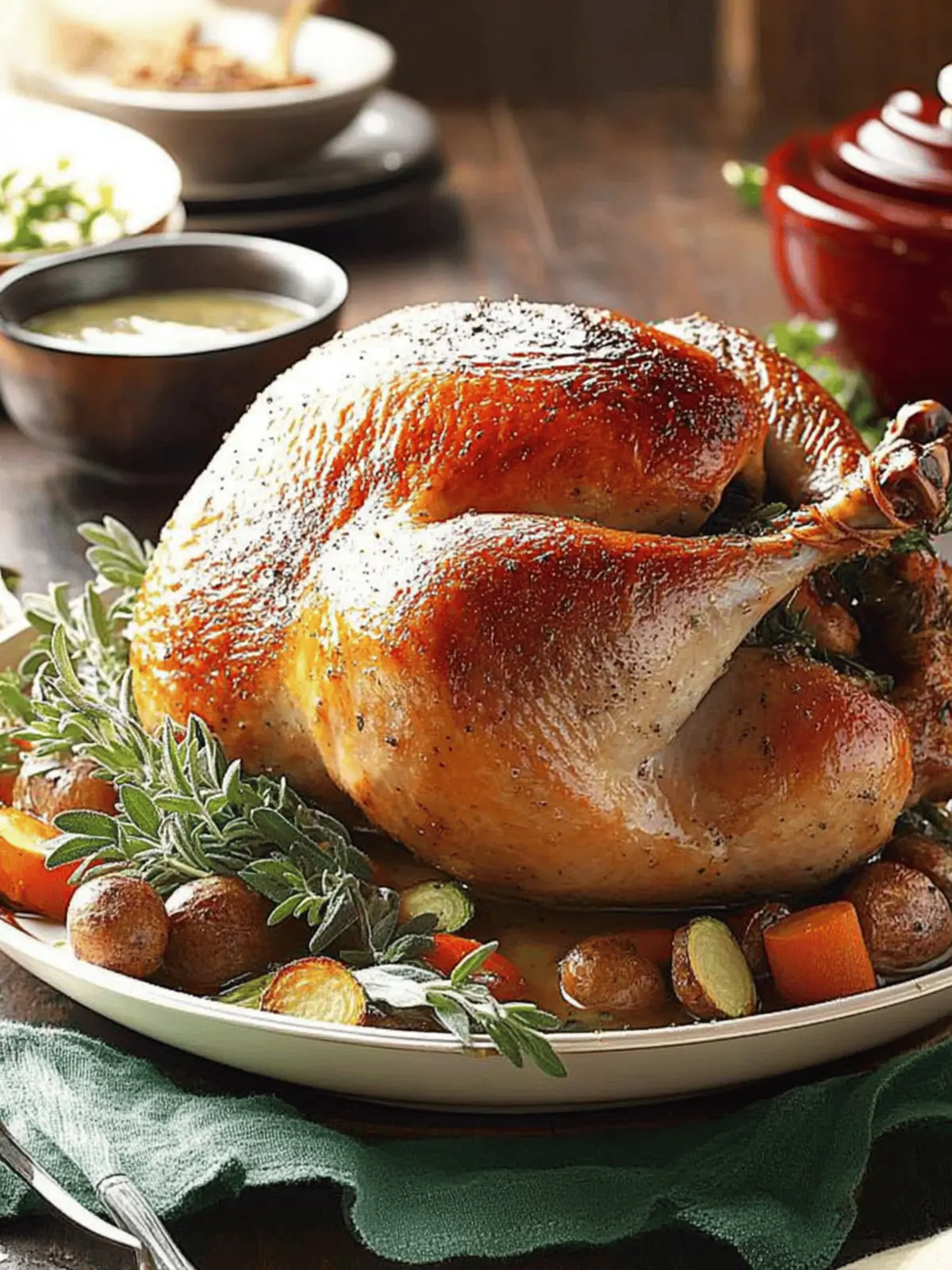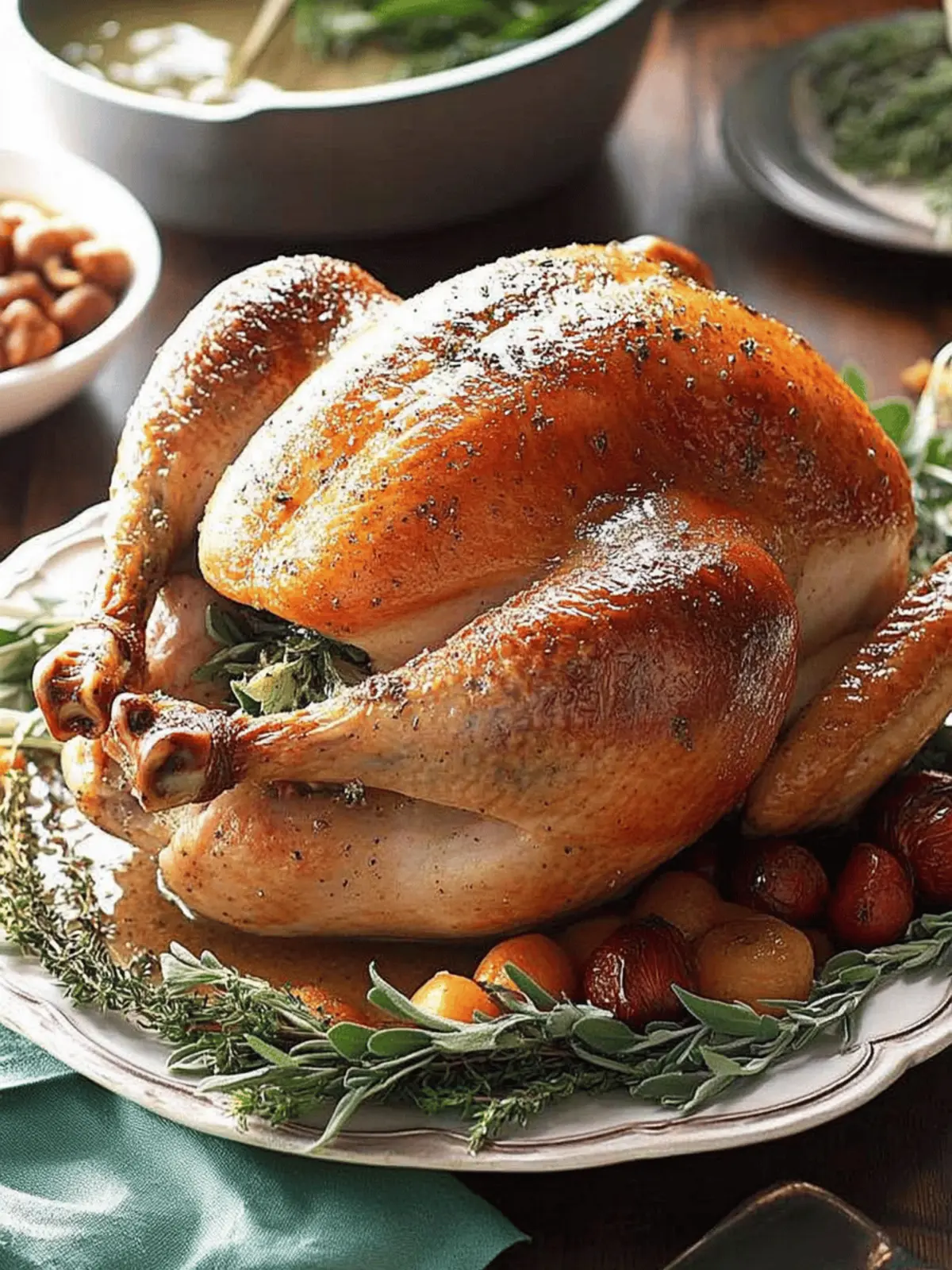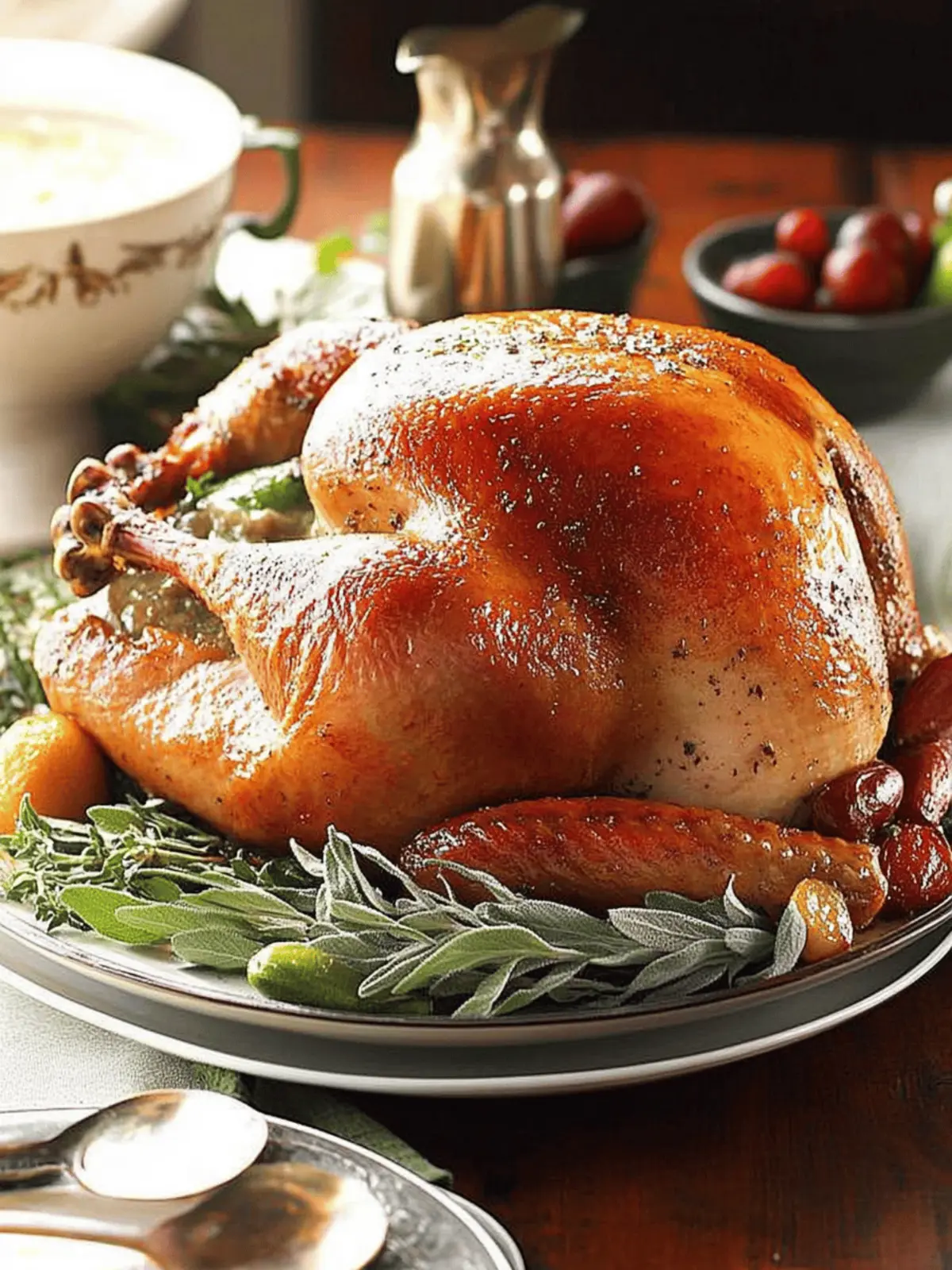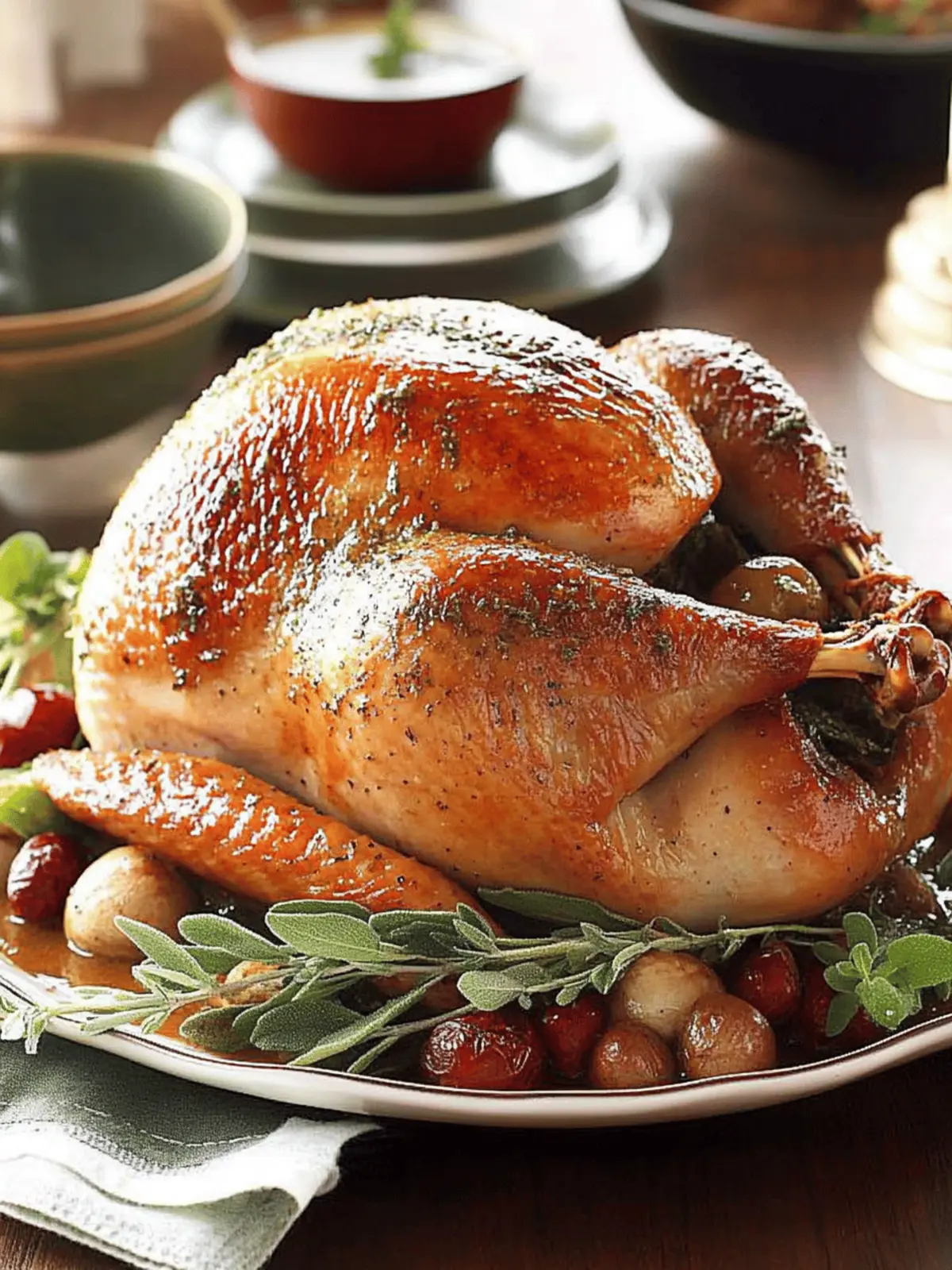As the crisp air signals the arrival of the holiday season, the thought of gathering around the table for a festive meal brings a smile to my face. Just the other day, I caught whiffs of roasted turkey and fresh herbs wafting from my oven, wrapping my kitchen in warmth. My Roasted Sage Turkey with Vegetable Gravy is not just a recipe; it’s a heartfelt tradition that transforms any gathering into a memorable feast.
Imagine pulling a succulent turkey from the oven, its golden-brown skin glistening and the rich aroma of sage and thyme filling the room—a centerpiece destined to impress. This dish seamlessly pairs juicy turkey with a velvety vegetable gravy, ensuring every bite is bursting with flavor. Whether you’re hosting a cozy family gathering or a large holiday celebration, this recipe offers both ease and elegance without the stress of complicated cooking techniques. Get ready to elevate your holiday meal with a dish that’s both comforting and unforgettable!
Why will you love this Roasted Sage Turkey with Vegetable Gravy?
Comforting Tradition: This recipe captures the essence of home-cooked meals, perfect for warming hearts and filling bellies during holiday gatherings.
Flavors to Savor: The blend of sage and thyme creates an aromatic masterpiece that enhances the juicy turkey.
Effortless Preparation: Simple steps make this dish accessible for both novice and seasoned cooks alike.
Versatile Pairing: The delicious vegetable gravy complements not just the turkey, but also your favorite sides like mashed potatoes and green beans.
Memorable Experience: This turkey becomes the centerpiece of your meal, creating lasting memories around the table with friends and family.
Roasted Sage Turkey Ingredients
• Dive into the world of flavors with this Roasted Sage Turkey with Vegetable Gravy.
For the Turkey
- Turkey (14 to 16 pounds) – Choose a quality bird for the best flavor and tenderness.
- Kosher salt (1 tablespoon) – Enhances flavor and moisture for a juicy turkey.
- Ground sage (1 teaspoon) – Adds aromatic depth; substitute with poultry seasoning if needed.
- Garlic powder (1/2 teaspoon) – For a delicious hint of flavor; fresh garlic works as a great alternative.
- Fresh sage sprigs (3) – Essential for stuffing the turkey; thyme is a great substitute if necessary.
- Fresh thyme sprigs (4) – Balances flavors beautifully; can be replaced with Italian herbs as desired.
- Freshly ground pepper (1/2 teaspoon) – Used for seasoning; either black or white pepper depending on your taste.
For the Gravy
- Onion, chopped (1 large) – Provides sweetness and depth to the gravy.
- Celery ribs, chopped (3) – Adds aromatic and savory notes; swap with leeks for a milder flavor.
- Medium carrots, chopped (3) – Brings sweetness and color to the gravy; substitute with parsnips if preferred.
- Water (1-1/4 cups, divided) – For moisture and broth; chicken broth offers a richer flavor.
- Canola oil (3 tablespoons) – Helps achieve the perfect browning on your turkey; olive oil is a lovely alternative.
- White wine (3/4 cup) – Adds acidity for depth in flavor; use chicken broth for a non-alcoholic option.
- Reduced-sodium chicken broth (1 to 1-1/2 cups) – Essential for making gravy; homemade stock is highly recommended.
- All-purpose flour (1/4 cup) – Thickens the gravy to perfection; cornstarch can be a gluten-free alternative.
With these ingredients, you’re on your way to creating a stunning Roasted Sage Turkey with Vegetable Gravy that will warm the hearts of your loved ones this holiday season!
How to Make Roasted Sage Turkey with Vegetable Gravy
-
Prepare the turkey: Start by removing the giblets from the turkey and refrigerate the neck overnight. For a flavor boost, secure the turkey skin and stuff it generously with fresh sage and thyme.
-
Season the turkey: In a small bowl, mix together kosher salt, ground sage, and garlic powder. Rub this flavorful blend all over the turkey skin. For the best results, refrigerate the turkey uncovered overnight to allow the flavors to mesh.
-
Roast: Preheat your oven to a toasty 475°F. Place the seasoned turkey in the oven and roast it uncovered for about 40 minutes, or until the skin begins to crisp and turn golden brown.
-
Continue roasting: Lower the oven temperature to a cozy 350°F. Cover the turkey breast with foil to prevent over-browning, and continue roasting for an additional 1-1/2 to 2 hours, until the internal temperature reaches a satisfying 170°F-175°F.
-
Rest and make gravy: Once roasted to perfection, let the turkey rest for 20-30 minutes before carving. Meanwhile, use the delicious drippings to prepare the gravy by adding the chopped vegetables and blending as desired for a smooth texture.
Optional: Garnish with fresh herbs for a pop of color before serving.
Exact quantities are listed in the recipe card below.
How to Store and Freeze Roasted Sage Turkey
Room Temperature: Leftover turkey should not be left out for more than 2 hours to prevent spoilage.
Fridge: Store leftover sliced turkey in an airtight container for up to 4 days. Keep the vegetable gravy in a separate container for freshness.
Freezer: If you need to keep leftovers longer, freeze turkey in portioned airtight bags for up to 3 months. Gravy can be frozen separately for 2-3 months as well.
Reheating: Thaw turkey and gravy in the fridge overnight before reheating. Warm turkey in the oven at 325°F until heated through, and reheat gravy on the stove over low heat, stirring gently.
Roasted Sage Turkey with Vegetable Gravy Variations
Customize your turkey and gravy experience to suit your taste buds and dietary preferences!
-
Dairy-Free: Use olive oil instead of canola oil for the turkey, and replace butter in any gravy recipes with plant-based alternatives for a creamy finish.
Feel free to enhance the flavor with a splash of dairy-free almond milk as you whisk it all together. -
Gluten-Free: Swap all-purpose flour with cornstarch for thickening the gravy, ensuring a smooth and gluten-free sauce.
Just mix the cornstarch with a little cold chicken broth before whisking it into the drippings to avoid any clumps. -
Spicy Kick: Add a pinch of cayenne pepper or smoked paprika to your seasoning blend for a delightful heat that elevates the turkey’s flavor profile.
A subtle heat can perfectly complement the savory herbs, creating an unexpected twist in each bite. -
Citrusy Zest: Incorporate lemon or orange zest into the gravy for a bright and refreshing tang that balances the rich flavors.
This twist brings a lightness to the dish, making every mouthful feel vibrant and lively. -
Herb-Infused: Experiment with different herbs like tarragon, rosemary, or dill in the stuffing, giving a unique twist to the classic sage.
These fresh herbs weave a bouquet of flavors that can transform your turkey into an aromatic masterpiece. -
Vegetarian Gravy: Create a delicious vegetarian gravy using vegetable broth instead of chicken broth, ensuring everyone at the table can enjoy it.
Add a splash of soy sauce or miso for depth and flavor that rivals traditional gravy. -
Stuffing Variation: Swap the sage and thyme for Italian herbs like basil and oregano if you crave a Mediterranean flair in your turkey stuffing.
Imagine the delightful aroma that fills your kitchen, making mealtime feel like a trip to the Tuscan countryside! -
Sweet Addition: For an unexpected sweet touch, toss chopped dried fruit like cranberries or apricots into the gravy as it simmers.
This subtle sweetness can create a delightful contrast, enhancing the overall savory experience of the meal.
Expert Tips for Roasted Sage Turkey
- Pat it Dry: Ensure the turkey is thoroughly patted dry before seasoning. This will help achieve that beautifully crispy skin you desire.
- Use a Thermometer: For precise cooking, utilize a meat thermometer to check the internal temperature without piercing the bone. Aim for 170°F-175°F for juiciness.
- Uncover Overnight: Refrigerating the seasoned turkey uncovered overnight allows the skin to dry out slightly, which enhances the roasting process and flavor.
- Strain the Gravy: For a smooth and visually appealing gravy, strain the drippings after blending. This removes any lumps, ensuring a luxurious texture.
- Customize Herbs: Feel free to experiment with different herbs in your roasted sage turkey. Rosemary or oregano can offer a unique twist to the traditional flavor.
- Resting Time: Don’t skip the resting step! Let your turkey sit for 20-30 minutes after roasting. This allows juices to redistribute, making for a juicier turkey.
What to Serve with Roasted Sage Turkey with Vegetable Gravy?
The perfect holiday feast awaits with delicious sides that beautifully accompany your succulent turkey.
-
Creamy Mashed Potatoes: Their rich, buttery texture absorbs the savory gravy, creating a comforting bite that’s hard to resist. Pairing mashed potatoes with turkey is like bringing together old friends at the dinner table.
-
Green Bean Casserole: This classic dish adds a crunchy topping and earthy flavors, balancing the juicy turkey perfectly. The creamy sauce clings to the green beans, creating a delightful contrast in textures.
-
Baked Sweet Potatoes: Their natural sweetness complements the savory notes of the turkey, making every mouthful a delightful experience. Roasted with a hint of cinnamon, sweet potatoes bring a warm, cozy flavor to your holiday spread.
-
Cranberry Sauce: This tart and tangy condiment cuts through the richness of the turkey and gravy, adding a pop of freshness to every bite. A spoonful of cranberry sauce elevates your meal, brightening the flavors beautifully.
-
Stuffing: Whether it’s traditional or a twist with seasonal ingredients, stuffing adds a delightful, hearty element that melds with the turkey. Each forkful of herbaceous stuffing brings warmth and nostalgia, drawing everyone back to fond memories of past gatherings.
-
Roasted Brussels Sprouts: With their crispy, caramelized edges, Brussels sprouts offer a delicious bitterness that beautifully complements the richness of the gravy. Tossed with balsamic glaze, they add a touch of sophistication to your table setting.
-
Red Wine: A glass of full-bodied red wine enhances the flavors of the roasted turkey, making it an elegant addition to your holiday meal. Its deep notes match well with the savory herbs, creating a perfect pairing for your festive feast.
These suggestions will ensure your Roasted Sage Turkey with Vegetable Gravy shines at the center of your table, turning your holiday gathering into a warm and flavorful celebration!
Make Ahead Options
These Roasted Sage Turkey with Vegetable Gravy preparations are perfect for busy home cooks looking to save time on the big day! You can season the turkey with salt, sage, and garlic powder up to 24 hours in advance, refrigerating it uncovered to enhance flavor absorption. The vegetable gravy can also be made 3 days ahead; simply prepare the gravy and refrigerate it in an airtight container. When you’re ready to serve, just reheat the gravy gently on the stovetop while roasting the turkey, ensuring it is heated through before serving. This way, you’ll enjoy the same scrumptious quality without the last-minute hustle!
Roasted Sage Turkey with Vegetable Gravy Recipe FAQs
How do I select the perfect turkey for roasting?
Absolutely! When choosing your turkey, look for a 14 to 16-pound bird that is well-marbled and looks fresh. A good quality turkey should have no dark spots or bruises. If possible, opt for a heritage breed or an organic turkey for the best flavor and texture.
What are the best storage methods for leftover turkey and gravy?
For leftovers, store sliced turkey in an airtight container in the fridge for up to 4 days. Keep the vegetable gravy in a separate container to maintain its freshness. If you want to store them longer, use freezer-safe bags to keep turkey portions and gravy separately for up to 3 months. Just remember to label and date everything!
Can I freeze my roasted sage turkey and gravy?
Very! To freeze your roasted sage turkey, carve it into portions and wrap each piece tightly in plastic wrap before placing it in an airtight freezer bag. For gravy, allow it to cool completely, then store it in a freezer-safe container or bag. This way, both will maintain optimal quality for about 2-3 months. When you’re ready to enjoy them again, simply thaw overnight in the fridge before reheating.
What should I do if my turkey skin isn’t crispy?
No worries! If your turkey skin isn’t as crispy as you’d like, it may need a little more time or higher heat. Ensure you pat the turkey dry before seasoning; moisture prevents crispy skin. Also, during roasting, try increasing the heat to 400°F for the last 30 minutes of cooking and uncover the turkey (if you haven’t already) to help crisp it up!
Can I use different herbs in this recipe?
Absolutely! Feel free to substitute the fresh sage and thyme with other herbs based on your preference. Rosemary, oregano, or even a poultry seasoning blend can infuse delightful flavors into the turkey, giving you the flexibility to tailor the dish to your liking.
Are there any dietary considerations for guests with allergies?
Yes, definitely! Always be mindful of your guests’ dietary restrictions. This roasted sage turkey recipe is generally considered gluten-free if using cornstarch for thickening the gravy. Be cautious with the wine; you can substitute it with chicken broth for non-alcoholic options. Always check labels for any allergens, especially with store-bought broth and sauces, to ensure the dish is safe for everyone at your table.

Savory Roasted Sage Turkey with Vegetable Gravy Delight
Ingredients
Equipment
Method
- Prepare the turkey by removing the giblets and refrigerating the neck overnight. Stuff it with fresh sage and thyme.
- Season the turkey with kosher salt, ground sage, and garlic powder. Rub this blend over the skin and refrigerate uncovered overnight.
- Preheat oven to 475°F. Roast turkey uncovered for about 40 minutes until the skin is crisp and golden brown.
- Lower temperature to 350°F, cover the breast with foil, and roast for 1-1/2 to 2 hours until internal temperature reaches 170°F-175°F.
- Let turkey rest for 20-30 minutes before carving. Prepare the gravy using the drippings and blended vegetables.








